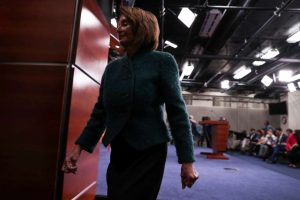JANUARY 17, 2019
 House Speaker Nancy Pelosi (D-Calif.) speaks to reporters a meeting with President Trump at the White House on Jan. 9, 2019. – Jabin Botsford
House Speaker Nancy Pelosi (D-Calif.) speaks to reporters a meeting with President Trump at the White House on Jan. 9, 2019. – Jabin Botsford
WASHINGTON, D.C. – House Democrats on Wednesday were making plans to undermine President Trump at his Jan. 29 State of the Union address. Just past 8:30 a.m., the leadership’s communications arm sent an email to lawmakers urging them to bring furloughed federal workers or other “message-related” guests to the nationally televised event.
Unknown to most of her caucus, however, House Speaker Nancy Pelosi (D-Calif.) had decided on a more confrontational approach.
Addressing a closed-door meeting of House Democrats, the speaker read a letter she had just sent to Trump asking him to either postpone the speech until the federal government reopens or deliver the text in writing, citing security concerns.
Surprised Democratic lawmakers cheered their leader’s rationale: If the government stays shut down, Pelosi would deprive Trump of the spotlight he craves. To a president especially sensitive to acts of disrespect — and one with a hearty appetite for pomp and circumstance — the so-called unvitation was not merely a power play. It was a calculated personal slight.
In the two weeks since she reclaimed the speaker’s gavel, Pelosi has moved aggressively to leverage her decades of congressional experience to needle, belittle and undercut Trump with swipes at his competence and even his masculinity.
The two leaders are locked in a standoff over a partial government shutdown instigated by Trump’s demand that U.S. taxpayers fund a portion of his promised border wall. Both Trump and Pelosi are gambling that the other will bear the brunt of the blame as the economic impact worsens, with the shutdown now dragging on for nearly a month.
But Pelosi’s challenge to Trump also comes with a degree of risk, for her and for Democrats. The more she becomes the face of Trump’s opposition, the more Republicans will probably use her unpopularity nationally to label vulnerable House Democrats as Pelosi clones — a potentially potent line of attack against sitting lawmakers who cast votes in lock-step with party leaders.
Still, with a self-declared mandate to provide a check on the president’s power, Pelosi is helping to keep Democrats largely united while energizing liberals who have yearned for a leader to challenge Trump directly.
Rep. Steve Cohen (D-Tenn.) called her letter to Trump to delay the State of the Union speech her “Gene Hackman moment,” comparing it to an inspirational speech the actor gives a basketball team in the movie “Hoosiers.”
“It’s smart for two reasons,” Cohen said. “Number one, Pelosi would be right behind him, and she’d have to sit there as he put the onus on her for the shutdown. Number two, it gives him a reason to end the shutdown, because he loves the TV audience and the attention.”
Josh Holmes, an adviser to Senate Majority Leader Mitch McConnell (R-Ky.), called Pelosi “a total fighter.”
“She understands political leverage. She wields the knife,” Holmes said. But he argued that her call to delay Trump’s speech was “a major screw-up” and predicted it would backfire.
In her letter to Trump, Pelosi said the U.S. Secret Service and the Department of Homeland Security have been “hamstrung” by furloughs and therefore should not bear the burden of securing the president’s address in the House chamber. The White House had no immediate response, but Homeland Security Secretary Kirstjen Nielsen said her department and the Secret Service were “fully prepared to support and secure the State of the Union.”
Trump was largely indifferent to Pelosi’s letter Wednesday, according to two people familiar with his remarks about the issue who requested anonymity to speak about internal discussions. Trump and the White House decided not to respond because it was unclear whether Pelosi was actually canceling the event or just making a political statement, both of these people said.
Marc Short, the Trump White House’s former legislative affairs director, said if security truly were Pelosi’s concern, she would not have extended a formal invitation to Trump to deliver the address, which she did earlier this month after the shutdown began.
“If we really can’t secure the president of the United States in the Capitol, then we have a much bigger problem,” Short said. “It’s a bogus claim to say there are security concerns. Everybody can look at that and say she doesn’t want to give the president a platform to speak to the nation about border security.”
 U.S. House Speaker Nancy Pelosi (D-CA) departs at the end of her news conference at the U.S. Capitol in Washington, U.S. January 10, 2019. – REUTERS/Jonathan Ernst
U.S. House Speaker Nancy Pelosi (D-CA) departs at the end of her news conference at the U.S. Capitol in Washington, U.S. January 10, 2019. – REUTERS/Jonathan Ernst
House Minority Whip Steve Scalise (R-La.) said, “It’s just that Nancy Pelosi is afraid of hearing what the president has to say.”
One danger for Pelosi is that Democrats could eventually appear intransigent to voters. Having said she considers the president’s long-promised wall immoral — and joking that she would only agree to allocate a single dollar to it — Pelosi could find herself in a bind should Republicans offer a compromise deal that would partially meet Trump’s demand for $5.7 billion in wall funding.
Pelosi’s strategy for dealing with Trump was born of exasperation, advisers said. She has been deliberately trying to get under his skin and “to talk to him in a way he understands,” according to one person familiar with her views.
After Pelosi and Senate Minority Leader Charles E. Schumer’s Dec. 11 Oval Office meeting with Trump, their first since the midterm elections, the speaker-designate told House Democrats their session was like “a tinkle contest with a skunk” and that she felt his wall demand was “like a manhood thing for him,” according to an aide in the room.
Pelosi kept her digs coming. After Trump backed off his demand that the wall be built of cement, she suggested he wanted “a beaded curtain or something.” She has implied he cannot relate to furloughed workers and “thinks maybe they could just ask their father for more money,” a reference to the president’s inherited wealth. And she has described his behavior as unstable and childish.
“It’s a temper tantrum,” Pelosi said after Trump stalked out of a negotiating session last week. “I’m the mother of five, grandmother of nine. I know a temper tantrum when I see one.”
Pelosi is setting the tone for how her party plans to confront the president over the next two years — in the political and legal fights consuming Washington as well as the presidential campaign taking shape across the country.
“She’s had so much experience and has been attacked so much that she’s secure,” said Jennifer Palmieri, a longtime Democratic strategist. “She is a woman of power who knows how to use it and is not at all cowed by what [Trump’s] reaction is to her. It’s not a concern. That frees her to take actions that others might be afraid to do.”
Navigating among powerful men is old hat for Pelosi, the youngest of six children from a political family in Baltimore, growing up with five older brothers, one of whom followed their father’s footsteps into the mayor’s office. She rose as a political force in her own right, first as a California fundraiser and local party activist and then in Congress, at a time when men vastly outnumbered women in the profession.
Trump is a proud counterpuncher, but when it comes to Pelosi, he has pulled back on his jabs. That is deliberate, aides and advisers said, because the president believes she would help protect him from impeachment and because he considers her more reasonable than other Democrats.
Privately, one adviser said, Trump has complained about the quotes he reads from Pelosi about him in newspapers but has said he is impressed by her political savvy.
“He says Cryin’ Chuck and Nancy, not Cryin’ Chuck and Nasty Nancy or whatever,” said this adviser, who spoke on the condition of anonymity to discuss the president’s views, referring to Trump’s Twitter mentions of Pelosi and Schumer (D-N.Y.).
Democrats won 40 House seats in November’s midterm elections — their largest gain since the Watergate-era class of 1974 — after Republican anti-Pelosi ads failed.
Pelosi’s approval rating has improved since the election, but she remains unpopular. A Quinnipiac poll released this week found 35 percent of voters had a favorable opinion of her, up from 27 percent in mid-2017. The survey found 48 percent held an unfavorable image of Pelosi, largely unchanged from her unfavorable rating over the past five years. A number of polls have shown Pelosi is as popular or more popular than Trump.
On the campaign trail last fall, Trump’s aides encouraged him to attack Pelosi by name at his rallies. They argued with him that she was more unpopular with his supporters than his favorite foe, Hillary Clinton, according to one senior administration official.
But as soon as Pelosi secured the House majority, Trump decided to call and congratulate her, even though aides had told reporters he was not planning to do so.
White House aides said Trump respects Pelosi, and he has suggested they strike a deal on infrastructure. He often brings up Pelosi’s Catholic faith. Before one meeting last year, he asked her to pray, and at a meeting earlier this year, he said that the Vatican had a wall and that she was a “good Catholic,” according to someone familiar with the exchange.
Sam Nunberg, a former Trump campaign adviser, said the president probably figured he could manage Pelosi just as he dealt with foes in real estate.
“I think that, as usual, he thought he would be able to charm her and that at the end of the day, they would have this great bipartisan type of dealmaking,” he said. “I think it’s completely naive.”
Trump has sought to drive a wedge through Pelosi’s caucus, which includes centrists elected in districts he carried in 2016 as well as liberals already pushing for the president’s impeachment.
But for now, at least, Pelosi has kept her members united, in part with stealth moves like Wednesday’s State of the Union letter. She kept her plans a secret from most of her own leadership team, though she gave a heads-up to Schumer. The two have been working in sync, talking five to six times a day during the shutdown. Pelosi asked Schumer to trek across the Capitol Wednesday morning to attend the House caucus meeting and show his support for the plan, which he did.
Pelosi’s unexpected announcement did cause some confusion. House Majority Leader Steny H. Hoyer (D-Md.) went on CNN, without having carefully read the letter she sent to Trump, and incorrectly declared that the State of the Union was “off”, even though Pelosi made clear that if the government was fully funded before Jan. 29 the event could go forward.
Still, the move served to rally Democrats.
Rep. Max Rose, a centrist Democrat elected last fall in Trump-friendly Staten Island in New York, was one of seven Democrats in the “Problem Solvers Caucus” who went to the White House on Wednesday to meet with Trump. But he said he was solidly in Pelosi’s corner, even though he did not support her as speaker.
“She’s bailing the president out, man,” Rose said. “Do you think the president of the United States is going to deliver a State of the Union during a government shutdown and say it’s good?”
Courtesy/Source: Washington Post










































































































